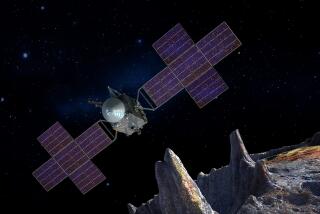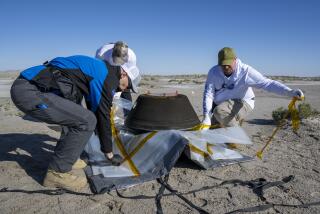Galileo Spacecraft Becomes First to Rendezvous With an Asteroid
- Share via
The Galileo spacecraft made history Tuesday when it became the first spacecraft to encounter an asteroid, a cold chunk of rock and metal left over from the formation of the solar system.
Galileo passed within 1,000 miles of Gaspra, snapping pictures as it sailed toward the asteroid at a relative velocity of 17,900 m.p.h., but it will be a year before scientists know whether their photos are any good. The spacecraft’s main antenna has refused to open, so the images were recorded on board and will be relayed back to the Jet Propulsion Laboratory in Pasadena via a smaller antenna when Galileo passes within 200 miles of Earth late next year.
The encounter marked a milestone in space exploration because no man-made object has ever passed close to an asteroid. Scientists have been forced to study asteroids only through ground-based telescopes, and since most asteroids are only a few miles in diameter those images have left much to be desired.
So Tuesday’s encounter, which was a byproduct of the tortured course Galileo must follow on its long journey to Jupiter, was awaited with much anticipation.
“We’ve had a great day,” mission director Neal E. Ausman said shortly after learning that the 2:37 p.m. rendezvous had been a “flawless” success. “The spacecraft did exactly what it was supposed to.”
Gaspra was almost 255 million miles from Earth when Galileo zipped by, and about 205 million miles from the sun. The encounter was just a bonus prize in the $1.4-billion exploration of the Jovian system, and the photographic challenge was immense.
Galileo flew past the shady side of Gaspra, and the asteroid is so small--measuring only about seven miles wide by 11 miles long--that engineers had been working for weeks to be sure that the camera did not miss the tiny rock entirely.
Like any asteroid, the position of Gaspra has been determined fairly well through ground observations. But what may seem precise from 255 million miles away may be considerably off during a close encounter.
To increase their odds, engineers at the Pasadena laboratory have been refining their estimate of Gaspra’s position as Galileo closed on the target. And it turns out that Galileo was right on target.
“We scored almost a perfect bulls-eye,” Ausman said. Galileo arrived within 1 1/2 seconds of the expected time of the encounter and only about three miles from where engineers expected it to be. “We were dead-on,” said navigation team chief William E. Kirhofer.
Once the position was determined, engineers could concentrate on snapping the pictures from the spacecraft, but that also was a bit of a challenge.
Anyone who has ever tried to take photographs from a moving car should have a slight idea of the challenge. How could the engineers be sure the asteroid was in the photographs since it is little more than a pinpoint in the sky, flying past at 17,900 m.p.h.?
The answer is to take a lot of pictures, sweeping the sky with the camera, thus ensuring that the target is in the camera’s view at least a couple of times.
So Galileo took 150 photos, some in color and some in black and white.
In about a year, scientists will find out if they were successful.
Success at Gaspra would be especially sweet because it may turn out that the encounter was the only show in town.
Galileo’s main antenna has refused to open, locking in a claw-like position that makes it useless. If engineers cannot figure out how to force it open--and so far every effort has failed--then when Galileo reaches Jupiter in 1995 it will be unable to send back the enormous amounts of scientific data and pictures it is supposed to collect during that two-year-long rendezvous.
Instead of a flood of data, there will be a mere trickle, and a project that many scientists and engineers have dedicated years of their careers to will be a colossal failure.
Galileo Meets Gaspra
Here are some facts about asteroid Gaspra, the target of exploration by the Galileo spacecraft: * Size: Small--a potato-shaped 6.2 miles by 6.8 miles by 11 miles.
* Orbit: Gaspra is on the inner edge of the main asteroid belt between Mars and Jupiter. It orbits the sun once every 3.3 Earth years.
* Rotation: Gaspra tumbles end-over-end every seven hours.
* Discovery: In 1916 by astronomer G. Neujmin at Simeis Observatory in the Ukraine.
* Name: Gaspra was named for a Crimean resort town once popular among astronomers.
* Composition: S-type asteroid, believed made of metallic and rocky minerals including iron, nickel, olivine and pyroxene.
* Color: Basic asteroid gray, with a hint of red.
SOURCE: Associated Press, Jet Propulsion Laboratory






